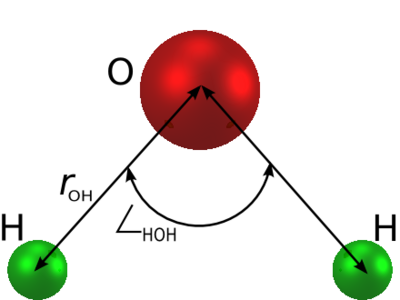SPC/E model of water: Difference between revisions
Carl McBride (talk | contribs) m (Started a Thermal conductivity section) |
Oliveirajs (talk | contribs) mNo edit summary |
||
| (5 intermediate revisions by 3 users not shown) | |||
| Line 19: | Line 19: | ||
| <math>q_{\mathrm{O}}</math> || <math>-0.8476 e</math> | | <math>q_{\mathrm{O}}</math> || <math>-0.8476 e</math> | ||
|- | |- | ||
| <math>q_{\mathrm{H}}</math> || <math>q_{\mathrm{O}}/2</math> (charge neutrality) | | <math>q_{\mathrm{H}}</math> || <math>|q_{\mathrm{O}}|/2</math> (charge neutrality) | ||
|} | |} | ||
The SPC/E model has a [[dipole moment]] of 2.351 D. (Ref. 1 Table I). | The SPC/E model has a [[dipole moment]] of 2.351 D. (Ref. 1 Table I). | ||
| Line 30: | Line 30: | ||
Recent simulations have demonstrated the existence of [[Plastic crystals | plastic crystal]] phases for the SPC/E model. | Recent simulations have demonstrated the existence of [[Plastic crystals | plastic crystal]] phases for the SPC/E model. | ||
<ref>[http://dx.doi.org/10.1063/1.3156856 J. L. Aragones and C. Vega "Plastic crystal phases of simple water models", Journal of Chemical Physics '''130''' 244504 (2009)]</ref> | <ref>[http://dx.doi.org/10.1063/1.3156856 J. L. Aragones and C. Vega "Plastic crystal phases of simple water models", Journal of Chemical Physics '''130''' 244504 (2009)]</ref> | ||
<ref>[https://doi.org/10.1021/acs.jpcb.1c05053 I. Skarmoutsos, A. Henao, J. Samios and E. Guardia "On the Different Faces of the Supercritical Phase of Water at a Near-Critical Temperature: Pressure-Induced Structural Transitions Ranging from a Gaslike Fluid to a Plastic Crystal Polymorph", Journal of Physical Chemistry B '''125''' 10260 (2022)]</ref> | |||
==Shear viscosity== | ==Shear viscosity== | ||
The [[shear viscosity]] for the SPC/E model is 0.729 mPa.s at 298 K and 1 bar <ref>[http://dx.doi.org/10.1063/1.3330544 Miguel Angel González and José L. F. Abascal "The shear viscosity of rigid water models", Journal of Chemical Physics '''132''' 096101 (2010)]</ref> (experimental value 0.896 mPa.s <ref>[http://dx.doi.org/10.1021/je049918m Kenneth R. Harris and Lawrence A. Woolf "Temperature and Volume Dependence of the Viscosity of Water and Heavy Water at Low Temperatures", Journal of Chemical & Engineering Data '''49''' pp. 1064-1069 (2004)]</ref>). | The [[shear viscosity]] for the SPC/E model is 0.729 mPa.s at 298 K and 1 bar <ref>[http://dx.doi.org/10.1063/1.3330544 Miguel Angel González and José L. F. Abascal "The shear viscosity of rigid water models", Journal of Chemical Physics '''132''' 096101 (2010)]</ref> (experimental value 0.896 mPa.s <ref>[http://dx.doi.org/10.1021/je049918m Kenneth R. Harris and Lawrence A. Woolf "Temperature and Volume Dependence of the Viscosity of Water and Heavy Water at Low Temperatures", Journal of Chemical & Engineering Data '''49''' pp. 1064-1069 (2004)]</ref>). | ||
Latest revision as of 16:10, 23 November 2023
The SPC/E (extended simple point charge model) [1] [2] is a slight reparameterisation of the SPC model of water, with a modified value for . The molecule is modelled as a rigid isosceles triangle, having charges situated on each of the three atoms. Apart from Coulombic interactions, the molecules interact via long-range Lennard-Jones sites, situated on the oxygen atoms. The parameters are as follows:

| parameter | value |
| Å | |
| kJ mol-1 | |
| Å | |
| (charge neutrality) |
The SPC/E model has a dipole moment of 2.351 D. (Ref. 1 Table I).
Surface tension[edit]
The surface tension has been studied for the SPC/E model by Vega and Miguel [3]
Phase diagram[edit]

Plastic crystal phases[edit]
Recent simulations have demonstrated the existence of plastic crystal phases for the SPC/E model. [4] [5]
Shear viscosity[edit]
The shear viscosity for the SPC/E model is 0.729 mPa.s at 298 K and 1 bar [6] (experimental value 0.896 mPa.s [7]).
Thermal conductivity[edit]
References[edit]
- ↑ H. J. C. Berendsen, J. R. Grigera, and T. P. Straatsma "The missing term in effective pair potentials", Journal of Physical Chemistry 91 pp. 6269 - 6271 (1987)
- ↑ Swaroop Chatterjee, Pablo G. Debenedetti, Frank H. Stillinger, and Ruth M. Lynden-Bell "A computational investigation of thermodynamics, structure, dynamics and solvation behavior in modified water models", Journal of Chemical Physics 128 124511 (2008)
- ↑ C. Vega and E. de Miguel "Surface tension of the most popular models of water by using the test-area simulation method", Journal of Chemical Physics 126 154707 (2007)
- ↑ J. L. Aragones and C. Vega "Plastic crystal phases of simple water models", Journal of Chemical Physics 130 244504 (2009)
- ↑ I. Skarmoutsos, A. Henao, J. Samios and E. Guardia "On the Different Faces of the Supercritical Phase of Water at a Near-Critical Temperature: Pressure-Induced Structural Transitions Ranging from a Gaslike Fluid to a Plastic Crystal Polymorph", Journal of Physical Chemistry B 125 10260 (2022)
- ↑ Miguel Angel González and José L. F. Abascal "The shear viscosity of rigid water models", Journal of Chemical Physics 132 096101 (2010)
- ↑ Kenneth R. Harris and Lawrence A. Woolf "Temperature and Volume Dependence of the Viscosity of Water and Heavy Water at Low Temperatures", Journal of Chemical & Engineering Data 49 pp. 1064-1069 (2004)
- ↑ Frank Römer, Anders Lervik, and Fernando Bresme "Nonequilibrium molecular dynamics simulations of the thermal conductivity of water: A systematic investigation of the SPC/E and TIP4P/2005 models", Journal of Chemical Physics 137 074503 (2012)
- Related reading











